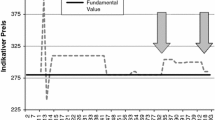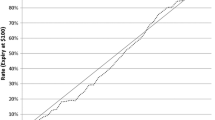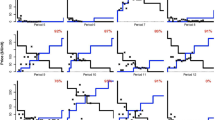Abstract
We study the effects of closing price manipulation in an experimental market to evaluate the social harm caused by manipulation. We find that manipulators, given incentives similar to many actual manipulation cases, decrease price accuracy and liquidity. The mere possibility of manipulation alters market participants’ behavior, leading to reduced liquidity. We find evidence that ordinary traders attempt to profitably counteract manipulation. This study provides examples of the strategies employed by manipulators, illustrates how these strategies change in the presence of detection penalties and assesses the ability of market participants to identify manipulation.
Similar content being viewed by others
References
Aggarwal, R. K., & Wu, G. (2006). Stock market manipulations. Journal of Business, 79, 1915–1953.
Allen, F., & Gale, D. (1992). Stock price manipulation. The Review of Financial Studies, 5, 503–529.
Becker, G. S. (1968). Crime and punishment: an economic approach. Journal of Political Economy, 76, 169–217.
Bhattacharya, U., & Daouk, H. (2002). The world price of insider trading. Journal of Finance, 57, 75–108.
Bloomfield, R., & O’Hara, M. (1999). Market transparency: who wins and who loses? Review of Financial Studies, 12, 5–35.
Cai, C. X., Hudson, R., & Keasey, K. (2004). Intra day bid-ask spreads, trading volume and volatility: recent empirical evidence on the London Stock Exchange. Journal of Business Finance & Accounting, 31, 647–676.
Camerer, C. F. (1998). Can asset markets be manipulated? A field experiment with racetrack betting. Journal of Political Economy, 106, 457–481.
Carhart, M., Kaniel, R., Musto, D., & Reed, A. (2002). Leaning for the tape: evidence of gaming behavior in equity mutual funds. Journal of Finance, 57, 661–693.
Comerton-Forde, C., & Putniņš, T. J. (2010). Measuring closing price manipulation. Journal of Financial Intermediation. doi:10.1016/j.jfi.2010.03.003.
Cumming, D., & Johan, S. (2007). Exchange surveillance index. Unpublished manuscript.
Forsythe, R., & Lundholm, R. (1990). Information aggregation in an experimental market. Econometrica, 58, 309–347.
Goetzmann, W., Ingersoll, J., Spiegel, M., & Welch, I. (2007). Portfolio performance manipulation and manipulation-proof performance measures. Review of Financial Studies, 20, 1503–1546.
Hanson, R., & Oprea, R. (2009). Manipulators increase information market accuracy. Economica, 76, 304–314.
Hanson, R., Oprea, R., & Porter, D. (2006). Information aggregation in an experimental market. Journal of Economic Behavior & Organization, 60, 449–459.
Hillion, P., & Suominen, M. (2004). The manipulation of closing prices. Journal of Financial Markets, 7, 351–375.
Khwaja, A. I., & Mian, A. (2005). Unchecked intermediaries: price manipulation in an emerging stock market. Journal of Financial Economics, 78, 203–241.
Kumar, P., & Seppi, D. J. (1992). Futures manipulation with cash settlement. Journal of Finance, 47, 1485–1502.
Kyle, A. S., & Viswanathan, S. (2008). How to define illegal price manipulation. American Economic Review, 98, 274–279.
Ni, S. X., Pearson, N. D., & Poteshman, A. M. (2005). Stock price clustering on option expiration dates. Journal of Financial Economics, 78, 49–87.
Pirrong, S. C. (1995). The self-regulation of commodity exchanges: the case of market manipulation. Journal of Law and Economics, 38, 141–206.
Plott, C. R., & Sunder, S. (1988). Rational expectations and the aggregation of diverse information in laboratory security markets. Econometrica, 56, 1085–1118.
Pritchard, A. C. (2003). Self-regulation and securities markets. Regulation, 26, 32–39.
Author information
Authors and Affiliations
Corresponding author
Rights and permissions
About this article
Cite this article
Comerton-Forde, C., Putniņš, T.J. Pricing accuracy, liquidity and trader behavior with closing price manipulation. Exp Econ 14, 110–131 (2011). https://doi.org/10.1007/s10683-010-9259-z
Received:
Accepted:
Published:
Issue Date:
DOI: https://doi.org/10.1007/s10683-010-9259-z




